Haonan An
NWaaS: Nonintrusive Watermarking as a Service for X-to-Image DNN
Jul 24, 2025Abstract:The intellectual property of deep neural network (DNN) models can be protected with DNN watermarking, which embeds copyright watermarks into model parameters (white-box), model behavior (black-box), or model outputs (box-free), and the watermarks can be subsequently extracted to verify model ownership or detect model theft. Despite recent advances, these existing methods are inherently intrusive, as they either modify the model parameters or alter the structure. This natural intrusiveness raises concerns about watermarking-induced shifts in model behavior and the additional cost of fine-tuning, further exacerbated by the rapidly growing model size. As a result, model owners are often reluctant to adopt DNN watermarking in practice, which limits the development of practical Watermarking as a Service (WaaS) systems. To address this issue, we introduce Nonintrusive Watermarking as a Service (NWaaS), a novel trustless paradigm designed for X-to-Image models, in which we hypothesize that with the model untouched, an owner-defined watermark can still be extracted from model outputs. Building on this concept, we propose ShadowMark, a concrete implementation of NWaaS which addresses critical deployment challenges by establishing a robust and nonintrusive side channel in the protected model's black-box API, leveraging a key encoder and a watermark decoder. It is significantly distinctive from existing solutions by attaining the so-called absolute fidelity and being applicable to different DNN architectures, while being also robust against existing attacks, eliminating the fidelity-robustness trade-off. Extensive experiments on image-to-image, noise-to-image, noise-and-text-to-image, and text-to-image models, demonstrate the efficacy and practicality of ShadowMark for real-world deployment of nonintrusive DNN watermarking.
Decoder Gradient Shield: Provable and High-Fidelity Prevention of Gradient-Based Box-Free Watermark Removal
Feb 28, 2025



Abstract:The intellectual property of deep image-to-image models can be protected by the so-called box-free watermarking. It uses an encoder and a decoder, respectively, to embed into and extract from the model's output images invisible copyright marks. Prior works have improved watermark robustness, focusing on the design of better watermark encoders. In this paper, we reveal an overlooked vulnerability of the unprotected watermark decoder which is jointly trained with the encoder and can be exploited to train a watermark removal network. To defend against such an attack, we propose the decoder gradient shield (DGS) as a protection layer in the decoder API to prevent gradient-based watermark removal with a closed-form solution. The fundamental idea is inspired by the classical adversarial attack, but is utilized for the first time as a defensive mechanism in the box-free model watermarking. We then demonstrate that DGS can reorient and rescale the gradient directions of watermarked queries and stop the watermark remover's training loss from converging to the level without DGS, while retaining decoder output image quality. Experimental results verify the effectiveness of proposed method. Code of paper will be made available upon acceptance.
GCP: Guarded Collaborative Perception with Spatial-Temporal Aware Malicious Agent Detection
Jan 05, 2025Abstract:Collaborative perception significantly enhances autonomous driving safety by extending each vehicle's perception range through message sharing among connected and autonomous vehicles. Unfortunately, it is also vulnerable to adversarial message attacks from malicious agents, resulting in severe performance degradation. While existing defenses employ hypothesis-and-verification frameworks to detect malicious agents based on single-shot outliers, they overlook temporal message correlations, which can be circumvented by subtle yet harmful perturbations in model input and output spaces. This paper reveals a novel blind area confusion (BAC) attack that compromises existing single-shot outlier-based detection methods. As a countermeasure, we propose GCP, a Guarded Collaborative Perception framework based on spatial-temporal aware malicious agent detection, which maintains single-shot spatial consistency through a confidence-scaled spatial concordance loss, while simultaneously examining temporal anomalies by reconstructing historical bird's eye view motion flows in low-confidence regions. We also employ a joint spatial-temporal Benjamini-Hochberg test to synthesize dual-domain anomaly results for reliable malicious agent detection. Extensive experiments demonstrate GCP's superior performance under diverse attack scenarios, achieving up to 34.69% improvements in AP@0.5 compared to the state-of-the-art CP defense strategies under BAC attacks, while maintaining consistent 5-8% improvements under other typical attacks. Code will be released at https://github.com/CP-Security/GCP.git.
Channel-Aware Throughput Maximization for Cooperative Data Fusion in CAV
Oct 06, 2024Abstract:Connected and autonomous vehicles (CAVs) have garnered significant attention due to their extended perception range and enhanced sensing coverage. To address challenges such as blind spots and obstructions, CAVs employ vehicle-to-vehicle (V2V) communications to aggregate sensory data from surrounding vehicles. However, cooperative perception is often constrained by the limitations of achievable network throughput and channel quality. In this paper, we propose a channel-aware throughput maximization approach to facilitate CAV data fusion, leveraging a self-supervised autoencoder for adaptive data compression. We formulate the problem as a mixed integer programming (MIP) model, which we decompose into two sub-problems to derive optimal data rate and compression ratio solutions under given link conditions. An autoencoder is then trained to minimize bitrate with the determined compression ratio, and a fine-tuning strategy is employed to further reduce spectrum resource consumption. Experimental evaluation on the OpenCOOD platform demonstrates the effectiveness of our proposed algorithm, showing more than 20.19\% improvement in network throughput and a 9.38\% increase in average precision (AP@IoU) compared to state-of-the-art methods, with an optimal latency of 19.99 ms.
Box-Free Model Watermarks Are Prone to Black-Box Removal Attacks
May 16, 2024


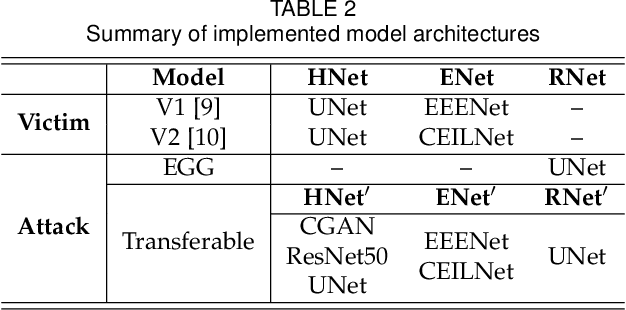
Abstract:Box-free model watermarking is an emerging technique to safeguard the intellectual property of deep learning models, particularly those for low-level image processing tasks. Existing works have verified and improved its effectiveness in several aspects. However, in this paper, we reveal that box-free model watermarking is prone to removal attacks, even under the real-world threat model such that the protected model and the watermark extractor are in black boxes. Under this setting, we carry out three studies. 1) We develop an extractor-gradient-guided (EGG) remover and show its effectiveness when the extractor uses ReLU activation only. 2) More generally, for an unknown extractor, we leverage adversarial attacks and design the EGG remover based on the estimated gradients. 3) Under the most stringent condition that the extractor is inaccessible, we design a transferable remover based on a set of private proxy models. In all cases, the proposed removers can successfully remove embedded watermarks while preserving the quality of the processed images, and we also demonstrate that the EGG remover can even replace the watermarks. Extensive experimental results verify the effectiveness and generalizability of the proposed attacks, revealing the vulnerabilities of the existing box-free methods and calling for further research.
SmartCooper: Vehicular Collaborative Perception with Adaptive Fusion and Judger Mechanism
Feb 02, 2024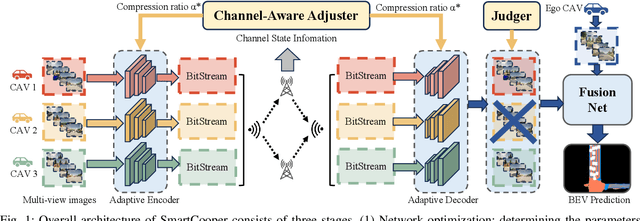
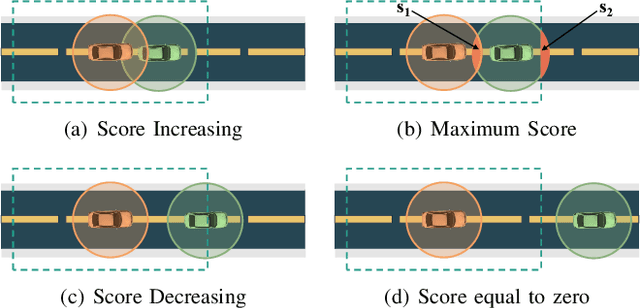
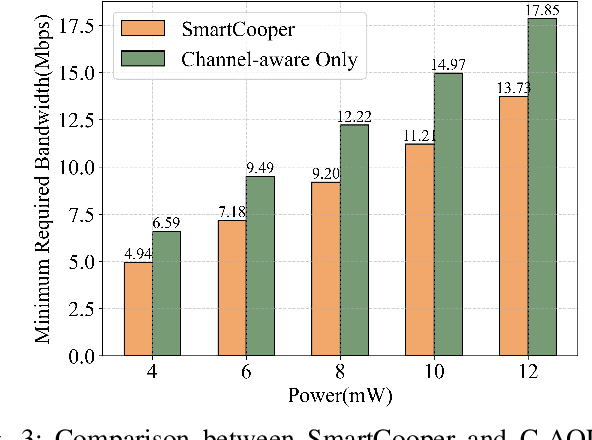
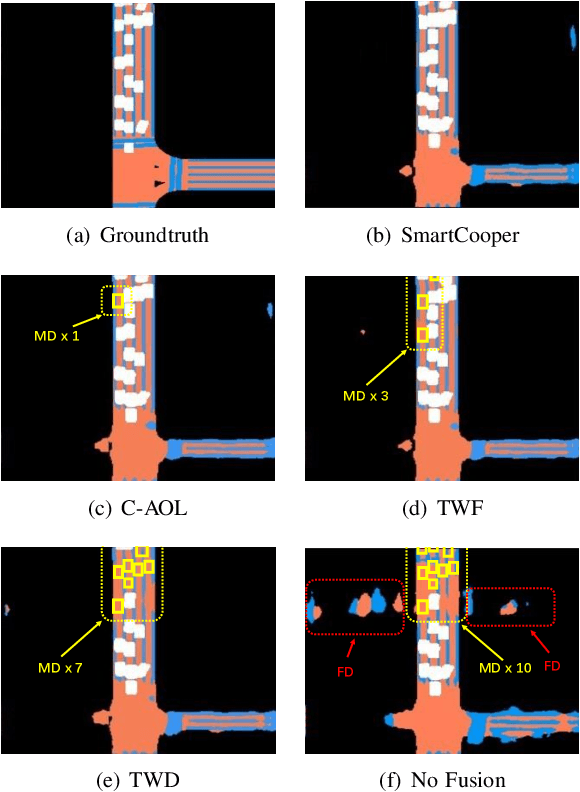
Abstract:In recent years, autonomous driving has garnered significant attention due to its potential for improving road safety through collaborative perception among connected and autonomous vehicles (CAVs). However, time-varying channel variations in vehicular transmission environments demand dynamic allocation of communication resources. Moreover, in the context of collaborative perception, it is important to recognize that not all CAVs contribute valuable data, and some CAV data even have detrimental effects on collaborative perception. In this paper, we introduce SmartCooper, an adaptive collaborative perception framework that incorporates communication optimization and a judger mechanism to facilitate CAV data fusion. Our approach begins with optimizing the connectivity of vehicles while considering communication constraints. We then train a learnable encoder to dynamically adjust the compression ratio based on the channel state information (CSI). Subsequently, we devise a judger mechanism to filter the detrimental image data reconstructed by adaptive decoders. We evaluate the effectiveness of our proposed algorithm on the OpenCOOD platform. Our results demonstrate a substantial reduction in communication costs by 23.10\% compared to the non-judger scheme. Additionally, we achieve a significant improvement on the average precision of Intersection over Union (AP@IoU) by 7.15\% compared with state-of-the-art schemes.
 Add to Chrome
Add to Chrome Add to Firefox
Add to Firefox Add to Edge
Add to Edge